TODAY’S FEED:😄😄😄
-CONTENTS-
- (CONFIDENTIAL) Nikola Tesla and edison’s secrets to be revealed.
- WHAT IS AC AND DC CURRENT?
- WHAT IS THE USE OF AC CURRENT IN OUR DAY TO DAY LIFE?
- WHAT IS THE USE OF DC IN OUR DAY TO DAY LIFE?
- WHAT IF DC CURRENT WILL REPLACE DEADLY AC CURRENT?
- WHAT WILL BE ITS SIDE EFFECTS?
- REFRENCES
- AUTHOR
Department of Energy
The War of the Currents: AC vs. DC Power
Home » The War of the Currents: AC vs. DC Power
Electrical transmission lines cross a snow-covered field in Dallas Dam, Oregon. | Photo courtesy of the Energy Department
Starting in the late 1880s, Thomas Edison and Nikola Tesla were embroiled in a battle now known as the War of the Currents.
Edison developed direct current — current that runs continually in a single direction, like in a battery or a fuel cell. During the early years of electricity, direct current (shorthanded as DC) was the standard in the U.S.
But there was one problem. Direct current is not easily converted to higher or lower voltages.
Tesla believed that alternating current (or AC) was the solution to this problem. Alternating current reverses direction a certain number of times per second — 60 in the U.S. — and can be converted to different voltages relatively easily using a transformer.
Edison, not wanting to lose the royalties he was earning from his direct current patents, began a campaign to discredit alternating current. He spread misinformation saying that alternating current was more dangerous, even going so far as to publicly electrocute stray animals using alternating current to prove his point.
The Chicago World’s Fair — also known as the World’s Columbian Exposition — took place in 1893, at the height of the Current War.
General Electric bid to electrify the fair using Edison’s direct current for $554,000, but lost to George Westinghouse, who said he could power the fair for only $399,000 using Tesla’s alternating current.
That same year, the Niagara Falls Power Company decided to award Westinghouse — who had licensed Tesla’s polyphase AC induction motor patent — the contract to generate power from Niagara Falls. Although some doubted that the falls could power all of Buffalo, New York, Tesla was convinced it could power not only Buffalo, but also the entire Eastern United States.
On Nov. 16, 1896, Buffalo was lit up by the alternating current from Niagara Falls. By this time General Electric had decided to jump on the alternating current train, too.
It would appear that alternating current had all but obliterated direct current, but in recent years direct current has seen a bit of a renaissance.
Today our electricity is still predominantly powered by alternating current, but computers, LEDs, solar cells and electric vehicles all run on DC power. And methods are now available for converting direct current to higher and lower voltages. Since direct current is more stable, companies are finding ways of using high voltage direct current (HVDC) to transport electricity long distances with less electricity loss.
So it appears the War of the Currents may not be over yet. But instead of continuing in a heated AC vs. DC battle, it looks like the two currents will end up working parallel to each other in a sort of hybrid armistice.
And none of that would be possible without the genius of both Tesla and Edison.
What is Alternating Current (AC)?
Chapter 1 – Basic AC Theory
Most students of electricity begin their study with what is known as direct current (DC), which is electricity flowing in a constant direction, and/or possessing a voltage with constant polarity. DC is the kind of electricity made by a battery (with definite positive and negative terminals), or the kind of charge generated by rubbing certain types of materials against each other.
Alternating Current vs Direct Current
As useful and as easy to understand as DC is, it is not the only “kind” of electricity in use. Certain sources of electricity (most notably, rotary electro-mechanical generators) naturally produce voltages alternating in polarity, reversing positive and negative over time. Either as a voltage switching polarity or as a current switching direction back and forth, this “kind” of electricity is known as Alternating Current (AC): Figure below
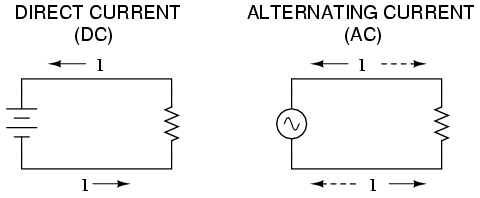
Direct vs alternating current
Whereas the familiar battery symbol is used as a generic symbol for any DC voltage source, the circle with the wavy line inside is the generic symbol for any AC voltage source.
One might wonder why anyone would bother with such a thing as AC. It is true that in some cases AC holds no practical advantage over DC. In applications where electricity is used to dissipate energy in the form of heat, the polarity or direction of current is irrelevant, so long as there is enough voltage and current to the load to produce the desired heat (power dissipation). However, with AC it is possible to build electric generators, motors, and power distribution systems that are far more efficient than DC, and so we find AC used predominately across the world in high power applications. To explain the details of why this is so, a bit of background knowledge about AC is necessary.
AC Alternators
If a machine is constructed to rotate a magnetic field around a set of stationary wire coils with the turning of a shaft, AC voltage will be produced across the wire coils as that shaft is rotated, in accordance with Faraday’s Law of electromagnetic induction. This is the basic operating principle of an AC generator, also known as an alternator: Figure below
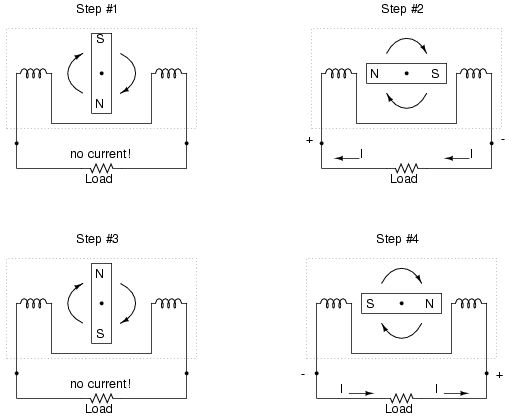
Alternator operation
Notice how the polarity of the voltage across the wire coils reverses as the opposite poles of the rotating magnet pass by. Connected to a load, this reversing voltage polarity will create a reversing current direction in the circuit. The faster the alternator’s shaft is turned, the faster the magnet will spin, resulting in an alternating voltage and current that switches directions more often in a given amount of time.
While DC generators work on the same general principle of electromagnetic induction, their construction is not as simple as their AC counterparts. With a DC generator, the coil of wire is mounted in the shaft where the magnet is on the AC alternator, and electrical connections are made to this spinning coil via stationary carbon “brushes” contacting copper strips on the rotating shaft. All this is necessary to switch the coil’s changing output polarity to the external circuit so the external circuit sees a constant polarity: Figure below
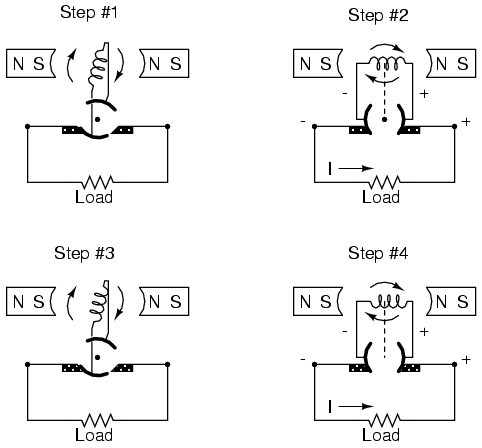
DC generator operation
The generator shown above will produce two pulses of voltage per revolution of the shaft, both pulses in the same direction (polarity). In order for a DC generator to produce constant voltage, rather than brief pulses of voltage once every 1/2 revolution, there are multiple sets of coils making intermittent contact with the brushes. The diagram shown above is a bit more simplified than what you would see in real life.
The problems involved with making and breaking electrical contact with a moving coil should be obvious (sparking and heat), especially if the shaft of the generator is revolving at high speed. If the atmosphere surrounding the machine contains flammable or explosive vapors, the practical problems of spark-producing brush contacts are even greater. An AC generator (alternator) does not require brushes and commutators to work, and so is immune to these problems experienced by DC generators.
AC Motors
The benefits of AC over DC with regard to generator design is also reflected in electric motors. While DC motors require the use of brushes to make electrical contact with moving coils of wire, AC motors do not. In fact, AC and DC motor designs are very similar to their generator counterparts (identical for the sake of this tutorial), the AC motor being dependent upon the reversing magnetic field produced by alternating current through its stationary coils of wire to rotate the rotating magnet around on its shaft, and the DC motor being dependent on the brush contacts making and breaking connections to reverse current through the rotating coil every 1/2 rotation (180 degrees).
Transformers
So we know that AC generators and AC motors tend to be simpler than DC generators and DC motors. This relative simplicity translates into greater reliability and lower cost of manufacture. But what else is AC good for? Surely there must be more to it than design details of generators and motors! Indeed there is. There is an effect of electromagnetism known as mutual induction, whereby two or more coils of wire placed so that the changing magnetic field created by one induces a voltage in the other. If we have two mutually inductive coils and we energize one coil with AC, we will create an AC voltage in the other coil. When used as such, this device is known as a transformer: Figure below

Transformer “transforms” AC voltage and current.
The fundamental significance of a transformer is its ability to step voltage up or down from the powered coil to the unpowered coil. The AC voltage induced in the unpowered (“secondary”) coil is equal to the AC voltage across the powered (“primary”) coil multiplied by the ratio of secondary coil turns to primary coil turns. If the secondary coil is powering a load, the current through the secondary coil is just the opposite: primary coil current multiplied by the ratio of primary to secondary turns. This relationship has a very close mechanical analogy, using torque and speed to represent voltage and current, respectively: Figure below
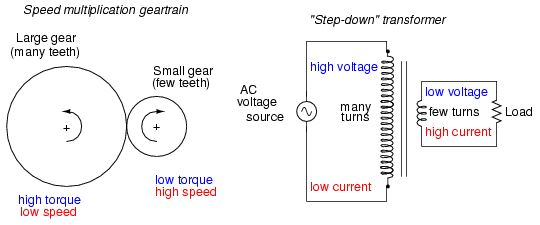
Speed multiplication gear train steps torque down and speed up. Step-down transformer steps voltage down and current up.
If the winding ratio is reversed so that the primary coil has less turns than the secondary coil, the transformer “steps up” the voltage from the source level to a higher level at the load: Figure below

Speed reduction gear train steps torque up and speed down. Step-up transformer steps voltage up and current down.
The transformer’s ability to step AC voltage up or down with ease gives AC an advantage unmatched by DC in the realm of power distribution in figure below. When transmitting electrical power over long distances, it is far more efficient to do so with stepped-up voltages and stepped-down currents (smaller-diameter wire with less resistive power losses), then step the voltage back down and the current back up for industry, business, or consumer use.
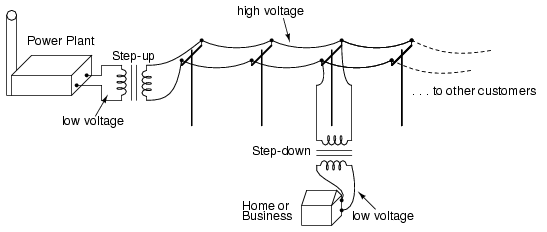
Transformers enable efficient long distance high voltage transmission of electric energy.
Transformer technology has made long-range electric power distribution practical. Without the ability to efficiently step voltage up and down, it would be cost-prohibitive to construct power systems for anything but close-range (within a few miles at most) use.
As useful as transformers are, they only work with AC, not DC. Because the phenomenon of mutual inductance relies on changingmagnetic fields, and direct current (DC) can only produce steady magnetic fields, transformers simply will not work with direct current. Of course, direct current may be interrupted (pulsed) through the primary winding of a transformer to create a changing magnetic field (as is done in automotive ignition systems to produce high-voltage spark plug power from a low-voltage DC battery), but pulsed DC is not that different from AC. Perhaps more than any other reason, this is why AC finds such widespread application in power systems.
Direct current
Direct current (DC) is the unidirectional flow of electric charge. A battery is a good example of a DC power supply. Direct current may flow in a conductor such as a wire, but can also flow through semiconductors, insulators, or even through a vacuum as in electron or ion beams. The electric current flows in a constant direction, distinguishing it from alternating current (AC). A term formerly used for this type of current was galvanic current.[1]
The abbreviations AC and DC are often used to mean simply alternating and direct, as when they modify current or voltage.[2][3]
Direct current may be obtained from an alternating current supply by use of a rectifier, which contains electronic elements (usually) or electromechanical elements (historically) that allow current to flow only in one direction. Direct current may be converted into alternating current with an inverter or a motor-generator set.
Direct current is used to charge batteries and as power supply for electronic systems. Very large quantities of direct-current power are used in production of aluminum and other electrochemical processes. It is also used for some railways, especially in urban areas. High-voltage direct current is used to transmit large amounts of power from remote generation sites or to interconnect alternating current power grids.
What are common DC applications?
This form of power is most commonly produced by sources such as solar cells, batteries, and thermocouples.
DC power is widely used in low voltage applications such as charging batteries, automotive applications, aircraft applications and other low voltage, low current applications. All solar panels nowadays produce DC power.
Common applications with DC power in the PV industry are portable solar systems and other off-grid appliances. Not using a solar inverter to convert DC to AC will keep the costs down for such systems.
Advantages and Disadvantages DC current
Nowadays for electric power distribution alternating current is mostly used, as it has significant advantages over direct current in transmission and transforming.
One of the biggest advantages of DC power is its ability to be used in special applications.
What are the applications of alternating current?
Alternating current is mainly used in the industry of the transportation and production of electricity. In fact, almost every household in the world is powered by AC. DC is generally not used for these purposes due to more power lost to heat compared to AC, higher risks of producing a fire, higher costs, and issues with converting high voltage and low current to low voltage and high current using transformers.
AC is also the more popular current when it comes to powering electric motors, a device that converts electric energy into mechanical energy. Some household appliances that we use that rely on this are, but aren’t limited to: refrigerators, dishwashers, garbage disposals, and toasters.
Direct current is popular in applications that contains batteries, are charged by plugging an AC to DC adapter into a wall, or uses a USB cable to charge. Examples of these products are flashlights, cell phones, modern day televisions (these contain an adapter which converts AC power to DC power), and hybrid cars.
What if ac current will replace dc current?
“DC is considerable MORE dangerous than AC, because it can cause muscles to spasm, and make you grip a live conductor harder. AC will “release” you 50 x a second…..”
How about: Try it out yourself?
The short story: No, the time a muscle takes to contract or loosen up with the very tightenedup state you get with direct high current muscle stimulation, is much longer than 1/50th of a second.
Before your grip looses noticably, your muscles will contract again.
Both will cause your muscles to spasm, Muscles don’t care if the direction of electrones is one way or the other. Muscles contract due to electric impulses or the lack thereoff, they don’t really care about electron flow.
High current is dangereus, no mater if it is DC or AC.
Saying one is more dangereus than the other, is like saying being burned at a 9000 degree stake is more dangereus than being burned at a 8000degree one.
in a way, DC can be safer than AC: (why?)
Imagine yourself working on wiring for an AC system. You weren’t wearing safety gears, didnt deactivate the main switch and you accidentally touched one of the terminals/bare wire. If it was the neutral, you’d be safe right? But if it was the hot wire…well at at least, you’ll get “punched” and will numb for a while but of course it can get worse.
Now imagine working on a DC wiring while not wearing safety gears and with the switch on: you touched the only one of the terminals or bare wires, you feel no electricity.
This is because DC needs to complete the circuit. While AC will flow towards the ground.
REFRENCES:
ENERGY.GOV
WIKIPEDIA
INSTRUCTABLES
AUTHOR:
ADITYA GAURAV
To read and explore more detailed information about this article visit now:


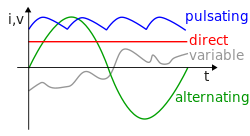

5 responses to “WHAT IF THE WHOLE WORLD WILL WORK ON DC CURRENT INSTEAD OF (DEADLY) AC?”
Hey, how’s it going?
I want to pass along some very important news that everyone needs to hear!
In December of 2017, Donald Trump made history by recognizing Jerusalem as the captial of Israel. Why is this big news? Because by this the Jewish people of Israel are now able to press forward in bringing about the Third Temple prophesied in the Bible.
Jewish Rabbis have publicly announced that their Messiah will be revealed in the coming years who will be a leader and spiritual guide to all nations, gathering all religions under the worship of one God. They deny Jesus as their Messiah, and the Bible tells us this Jewish Messiah will be the counterfiet that will bring about a false peace, and ultimatley the great tribulation.
They even printed a coin to raise money for the Temple with Donald Trumps face on the front and with king Cyrus'(who built the second Temple) behind him. On the back of the coin is an image of the third Temple.
More importantly, the power that runs the world wants to put a RFID microchip in our body making us total slaves to them. This chip matches perfectly with the Mark of the Beast in the Bible, more specifically in Revelation 13:16-18:
“He causes all, both small and great, rich and poor, free and slave, to receive a mark on their right hand or on their foreheads, and that no one may buy or sell except one who has the mark or the name of the beast, or the number of his name.
Here is wisdom. Let him who has understanding calculate the number of the beast, for it is the number of a man: His number is 666.”
Referring to the last days, this could only be speaking of a cashless society, which we have yet to see, but are heading towards. Otherwise, we could still buy or sell without the mark amongst others if physical money was still currency. This Mark couldn’t be spiritual because the word references two different physical locations. If it was spiritual it would just say in the forehead. RFID microchip implant technology will be the future of a one world cashless society containing digital currency. It will be implanted in the right-hand or the forehead, and we cannot buy or sell without it! We must grow strong in Jesus. AT ALL COSTS, DO NOT TAKE IT!
“Then a third angel followed them, saying with a loud voice, “If anyone worships the beast and his image, and receives his mark on his forehead or on his hand, he himself shall also drink of the wine of the wrath of God, which is poured out full strength into the cup of His indignation. He shall be tormented with fire and brimstone in the presence of the holy angels and in the presence of the Lamb. And the smoke of their torment ascends forever and ever; and they have no rest day or night, who worship the beast and his image, and whoever receives the mark of his name” (Revelation 14:9-11).
People have been saying the end is coming for many years, but we needed two key things. One, the Third Temple, and two, the technology for a cashless society to fulfill the prophecy of the Mark of the Beast.
Visit http://WWW.BIBLEFREEDOM.COM to see proof for these things and much more!
If you haven’t already, it is time to seek God with all your heart. Jesus loves you more than you could imagine. He wants to have a relationship with you and redeem you from your sins. Turn to Him and repent while there is still hope! God bless!
LikeLike
What’s up, all the time i used to check blog posts here in the early hours in the dawn, for the reason that i like to learn more and more.|
LikeLike
Hi! I’ve been following your weblog for a while now and finally got the bravery to go ahead and give you a shout out from Humble Tx! Just wanted to say keep up the fantastic work!|
LikeLike
fantastic publish, very informative. I’m wondering why the other experts of this sector don’t realize this. You must continue your writing. I’m confident, you’ve a great readers’ base already!
LikeLike
Thanks for the marvelous posting! I seriously enjoyed reading it, you could be a great author.I will be sure to bookmark your blog and may come back later in life. I want to encourage continue your great writing, have a nice evening!
LikeLike